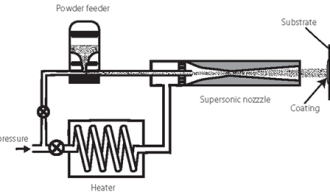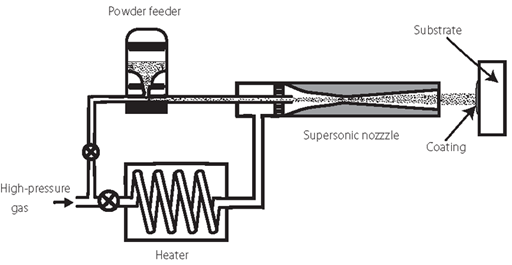Cold spraying and thermal spraying methods both improve or restore the surface of a solid material by applying a coating of another material to bond with it. As the names suggest, the primary difference between the two methods is the temperature involved in creating this bond.
Cold spraying
Cold spraying is a relatively recently developed technology. Far from replacing the established thermal spray methods, it supplements them by facilitating application in more temperature-sensitive areas or those that simply cannot be disassembled for treatment.
In cold spraying, powdered materials are accelerated to supersonic speeds using high-pressure gasses heated via electricity rather than heating the coating material to achieve melting point and allowing a bond to form with the solid material as it cools.
Assisted by the design of the application gun’s nozzle, the heat energy is converted to kinetic energy, hurling the coating particles at such speeds that they undergo plastic deformation and bond with the surface of the solid material.
As this finely directed method can be used in difficult to reach places, such as gearbox housings in helicopters, it is of interest to the aerospace industry. The Netherlands Aerospace Centre has recently proposed a joint research programme into its applications.
Thermal spraying
Thermal spraying can be used for virtually any material that can be melted, which means there are many metallic, polymer and even ceramic materials that can be combined to give the desired combination of flexibility, hardness and durability for a particular component. Various combinations and their practical applications can be seen in the products supplied by companies such as https://www.poeton.co.uk/standard-treatments/plasma-coatings/.
These combinations are applied through one of the four main methods below, which were also compared by leading industry publication Products Finishing alongside recommendations for each method’s practical application.
Thermal plasma spray
Thermal plasma spraying uses electricity to form a high-temperature plasma jet into which the coating materials and an inert gas are fed. The plasma simultaneously melts the coating materials and causes the gas to expand rapidly, creating a high-velocity spray of molten particles that adhere to the solid material and cools to form a protective layer.
Arc spraying
Arc spraying also utilises electricity, in this case to cause the tips of two wires of the required coating metal to melt where they touch. An atomising gas strips the molten metal from the wires, transporting it to the solid material as a coating.
Flame spraying
Flame spraying is perhaps the longest established technique whereby oxygen and a fuel such as acetylene are fed through a torch and ignited to form an intense flame. The coating material is then fed into this flame as a powder or wire, with the flame simultaneously melting and applying it.
High-velocity oxy-fuel process (HVOF)
HVOF simultaneously injects gasses directly into the combustion chamber of a torch at high pressure and ignites them to force powdered coating materials at supersonic speeds onto the solid material.



